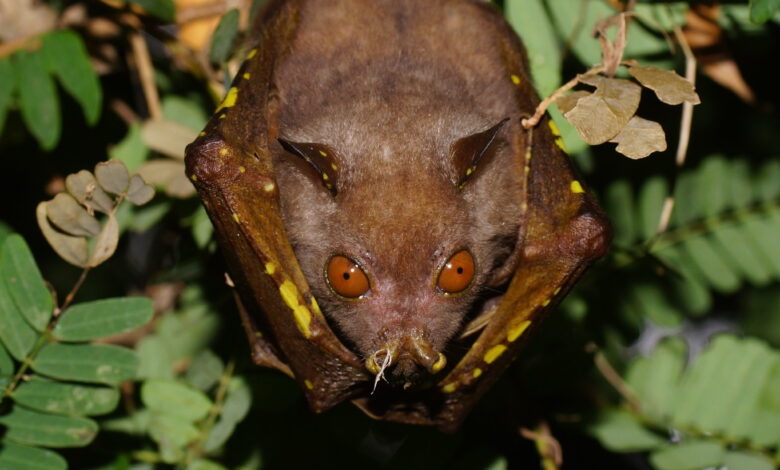
Top 5 Weirdest Creatures of the Philippines
The Philippines, renowned for its rich biodiversity and unique ecosystems, is home to a plethora of extraordinary creatures. From deep-sea dwellers to elusive forest inhabitants, here are five of the weirdest creatures found in this tropical archipelago.
1. Philippine Tube-Nosed Fruit Bat
One of our first weirdest creatures on this list is the Philippine Tube-Nosed Fruit Bat. The Philippine tube-nosed fruit bat (Nyctimene rabori) is a unique and fascinating species endemic to the Philippines. Named for its distinctive tubular nostrils that protrude from its face, this small bat has a wingspan of about 40-45 cm. They can be seen flying through the rainforests of Sibuyan, Negros, and Cebu. Despite their alien-like facial features, these fruit bats only feed on fruits and insects.
Nocturnal by nature, the Philippine tube-nosed fruit bat feeds on fruits, nectar, and occasionally insects, playing a crucial role in seed dispersal and the health of forest ecosystems. However, this species faces significant threats, primarily from habitat loss due to deforestation and agricultural expansion. Hunting and the disturbance of roosting sites further endanger its population. Conservation efforts focus on protecting and restoring habitats, as well as raising awareness about the ecological importance of fruit bats to ensure the survival of this remarkable species.
2. Palawan Bearded Pig (Sus ahoenobarbus)
The Palawan bearded pig (Sus ahoenobarbus) is a distinctive and remarkable species endemic to the Palawan group of islands in the Philippines. This wild pig is easily recognizable by the prominent, coarse beard of hair that extends from its cheeks and chin, giving it a unique and somewhat rugged appearance. The body is generally covered in dark, bristly hair, which can vary in density and length.
Typically, adult Palawan bearded pigs are medium-sized, with males being larger and more robust than females. These pigs have a relatively elongated head and a pronounced snout, which they use to forage for food. Their diet is omnivorous, consisting of roots, tubers, fruits, small animals, and occasionally carrion. Their foraging behavior plays a significant role in the ecosystem, as it helps in soil aeration and seed dispersal.
Palawan bearded pigs inhabit a range of environments, including primary and secondary forests, grasslands, and even agricultural areas. They are highly adaptable and can be found from sea level to mountainous regions. However, their preference is for dense forested areas where they can find ample food and cover.
3. Terrible Claw Lobster
The Terrible Claw Lobster (Dinochelus ausubeli) is an extraordinary deep-sea crustacean that was discovered relatively recently, in 2007, during a marine biodiversity expedition in the Philippines. This unusual lobster belongs to the family Nephropidae and is named for its distinctively large, asymmetrical claws, which are its most striking feature. The larger of the two claws, often referred to as the “terrible claw,” is incredibly elongated and bears numerous spines, giving it a formidable appearance.
This lobster is typically found at depths ranging from 250 to 300 meters (820 to 984 feet), inhabiting the dark, cold waters of the deep sea. Its body is relatively small, measuring about 31 mm (1.2 inches) in total length, excluding its claws. The carapace, or shell, of the Terrible Claw Lobster is smooth and has a pale, translucent color, which is common among deep-sea creatures that live in environments with little to no light.
The diet and specific behaviors of the Terrible Claw Lobster remain largely unknown due to the challenges of studying such deep-sea organisms. However, like other lobsters, it is presumed to be a scavenger and predator, using its large claw to capture and manipulate prey.
4. Palawan Bearcat
The Palawan Bearcat, also known as the binturong (Arctictis binturong), is a unique and intriguing mammal native to the island of Palawan in the Philippines. Despite its common name, the Palawan Bearcat is neither a bear nor a cat; it belongs to the family Viverridae, which includes civets and genets. Its appearance, however, combines features reminiscent of both bears and cats, with a sturdy, bear-like body and a long, bushy, cat-like tail. Yes, it definitely belongs to this list of weirdest creatures.
Endemic to the island of Palawan, the binturong primarily inhabits tropical forests, including primary and secondary forests. It is an arboreal species, spending much of its time in the canopy. The dense forest provides ample opportunities for foraging and shelter from predators.
READ: Prehistoric Animals Still Alive in the Philippines
5. The tamaraw (Bubalus mindorensis)
The tamaraw (Bubalus mindorensis), also known as the Mindoro dwarf buffalo, is a critically endangered species endemic to the island of Mindoro in the Philippines. This small, stocky bovine stands about 100 to 105 centimeters (39 to 41 inches) at the shoulder and weighs between 200 to 300 kilograms (440 to 660 pounds).
Herbivorous by nature, tamaraws primarily feed on grasses, bamboo shoots, and various other vegetation, typically grazing during the early morning and late afternoon to avoid the midday heat. These animals are usually solitary, coming together only during the breeding season. Known for their elusive and shy nature, tamaraws are difficult to observe in the wild, but they can become aggressive and defend themselves with their sharp horns when threatened.
Whether you’re a biologist, an adventurer, or simply a lover of nature’s oddities, exploring the Philippines promises encounters with some of the weirdest creatures that challenge our understanding of the natural world and inspire awe at the wonders of evolution.
